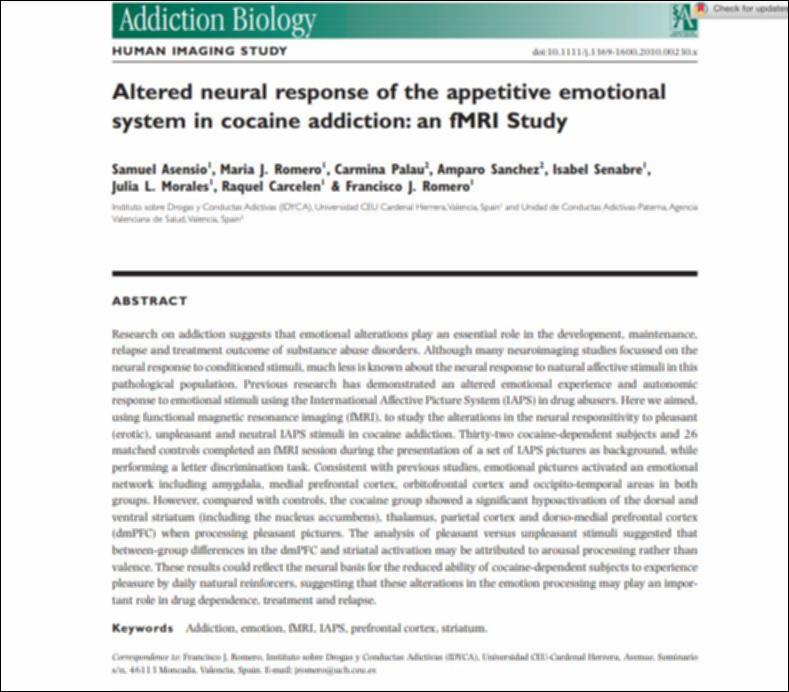Please use this identifier to cite or link to this item:
http://hdl.handle.net/10637/15190Altered neural response of the appetitive emotional system in cocaine addiction: an fMRI study

See/Open:
Altered_Asensio_AB_2010.JPG
117,82 kB
JPEG
See/Open:
Altered_Asensio_AB_2010.pdf
Restricted Access
348,87 kB
Adobe PDF
Request a copy
| Title: | Altered neural response of the appetitive emotional system in cocaine addiction: an fMRI study |
| Authors : | Asensio Alcaide, Samuel Romero, María J. Palau, Carmina Sánchez Fideli, María Amparo Senabre, Isabel Morales, Julia L. Carcelén González, Raquel Romero Gómez, Francisco Javier |
| Keywords: | Cerebro; Brain; Estupefaciente; Narcotic drugs; Adicción; Drug abuse; Fisiopatología; Physiology, Pathological; Redes neuronales (Neurobiología); Neural networks (Neurobiology) |
| Publisher: | John Wiley & Sons Society for the Study of Addiction |
| Citation: | Asensio, S., Romero, M.J., Palau, C., Sanchez, A., Senabre, I., Morales, J.L., Carcelen, R. & Romero, F.J. (2010). Altered neural response of the appetitive emotional system in cocaine addiction: an fMRI study. Addiction Biology, vol. 15, i. 4 (oct.), pp. 504–516. DOI: https://doi.org/10.1111/j.1369-1600.2010.00230.x |
| Abstract: | Research on addiction suggests that emotional alterations play an essential role in the development, maintenance, relapse and treatment outcome of substance abuse disorders. Although many neuroimaging studies focussed on the neural response to conditioned stimuli, much less is known about the neural response to natural affective stimuli in this pathological population. Previous research has demonstrated an altered emotional experience and autonomic response to emotional stimuli using the International Affective Picture System (IAPS) in drug abusers. Here we aimed, using functional magnetic resonance imaging (fMRI), to study the alterations in the neural responsitivity to pleasant (erotic), unpleasant and neutral IAPS stimuli in cocaine addiction. Thirty-two cocaine-dependent subjects and 26 matched controls completed an fMRI session during the presentation of a set of IAPS pictures as background, while performing a letter discrimination task. Consistent with previous studies, emotional pictures activated an emotional network including amygdala, medial prefrontal cortex, orbitofrontal cortex and occipito-temporal areas in both groups. However, compared with controls, the cocaine group showed a significant hypoactivation of the dorsal and ventral striatum (including the nucleus accumbens), thalamus, parietal cortex and dorso-medial prefrontal cortex (dmPFC) when processing pleasant pictures. The analysis of pleasant versus unpleasant stimuli suggested that between-group differences in the dmPFC and striatal activation may be attributed to arousal processing rather than valence. These results could reflect the neural basis for the reduced ability of cocaine-dependent subjects to experience pleasure by daily natural reinforcers, suggesting that these alterations in the emotion processing may play an important role in drug dependence, treatment and relapse. |
| Description: | Este recurso no está disponible en acceso abierto por política de la editorial. |
| URI: | http://hdl.handle.net/10637/15190 |
| Rights : | http://creativecommons.org/licenses/by-nc-nd/4.0/deed.es |
| ISSN: | 1355-6215 1369-1600 (Electrónico) |
| Issue Date: | Oct-2010 |
| Center : | Universidad Cardenal Herrera-CEU |
| Appears in Collections: | Dpto. Ciencias Biomédicas |
Items in DSpace are protected by copyright, with all rights reserved, unless otherwise indicated.

